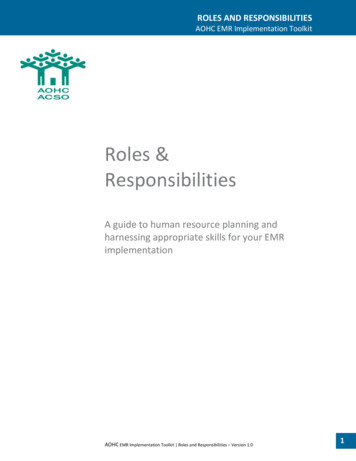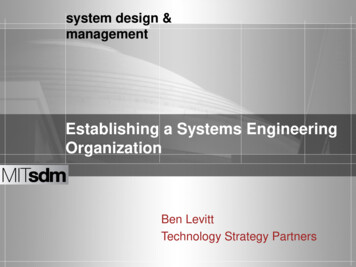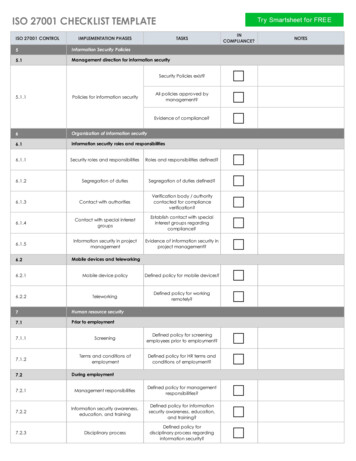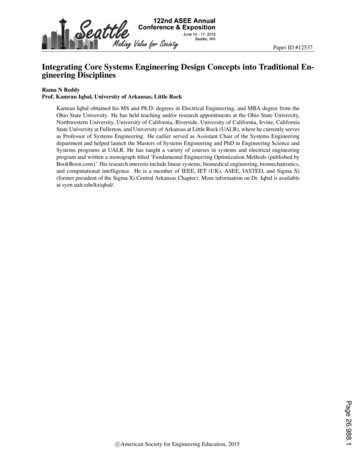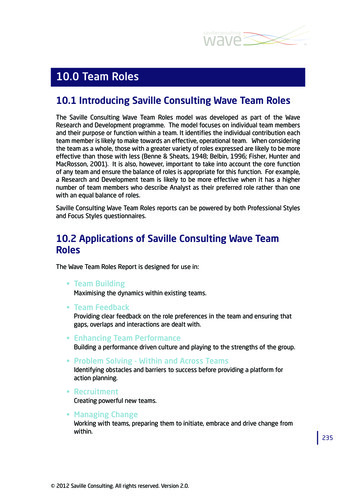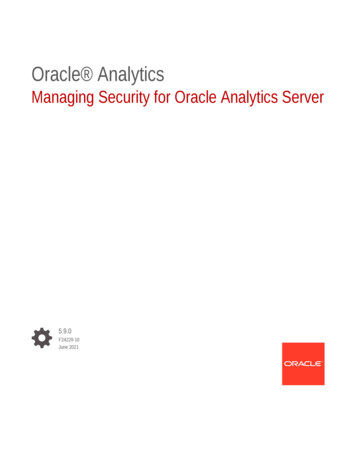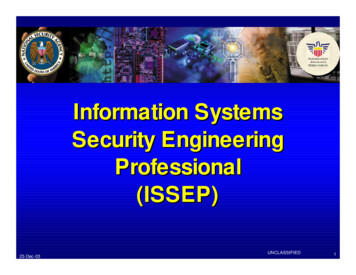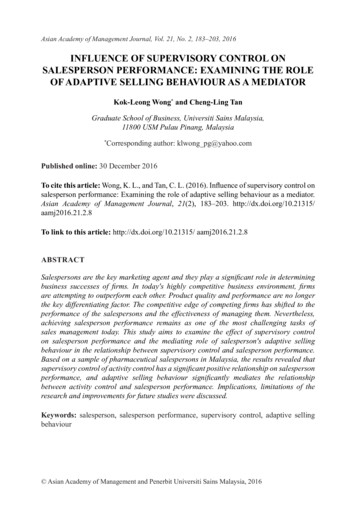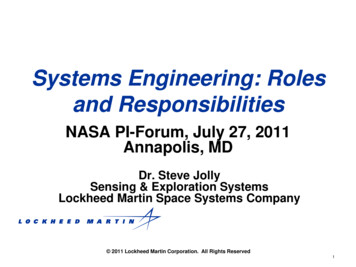
Transcription
Systems Engineering: Rolesand ResponsibilitiesNASA PI-Forum, July 27, 2011Annapolis, MDDr. Steve JollySensing & Exploration SystemsLockheed Martin Space Systems Company 2011 Lockheed Martin Corporation. All Rights Reserved1
Making Decisions With Uncertainty Engineers are Relatively Good at Logical Decisions– The Problem is With the Assumptions Testing the Assumptions is the Most Important Trait of a GoodSystems Engineer -Remember You are the Easiest One to Fool In Most Cases, an 80% Solution is Good Enough, but not always!Navigation B-Plane PlotThis is Where the“Data” Said We Were3 Sigma Target Ellipse175 km*135 kmControllability Limit57 kmMarsSurface* ****** * ** **This is Where We Really Were!Solutions should have tighter overall grouping! (Hindsight)2
Systems Engineering Key Lessons Truth of DeLuca’s Law (from Political Savvy)– [Space System development is] Not a rational system thathappens to involve humans, but a human systemattempting to act rationally Configuration control is good– Even very early in project life cycle All mistakes are stupid– We miss the obvious Test Like You Fly (TLYF)/Test at System Levelcannot be the only verification approach– Need to do things right the first time (at lowest level) Distraction can be dangerous– We miss the critical while focused on the urgent Non-linear affect of requirements creep3
Lessons Which We Must Not Re-Learn!Mars ’98 riableInadequateMarginsLaunch VehicleFixed(Some Relief)CostFixed4
Systems Engineering Precepts Working Definition: The art and science of guiding theend-to-end engineering of complex space systems– Art because it involves extensive people skills and leadership– Science because it requires rigorous applications of toolsand methodologies Key Objectives1. Employ First Principles Approach Keep the critical-to-customer requirements always in mind Everything else supports these2. Bring the entire project together Big Tent, end-to-end, Diversity of ideas are good3. Vertical and horizontal integration4. Verification and validation Separate disciplines Little “i” V&V5
Systems Engineering Leads theTechnical Execution of the Project! Accomplished by Establishing the TechnicalRhythm (Cadence) by Which the Project Marches This is the Weekly/Periodic Procedure that:––––Controls Changes to the Technical BaselineMatures the System through the Project Life-CycleReduces/Accepts System RiskDirectly affects the Life-Cycle Cost Outcome Needs to be In-Place at Contract Start– Can be Tailored for Early Phases in the Life-Cycle Must Not Strangle the Project with Many Meetings– Attendance and Periodicity Carefully Architected– Everyone Hates Long, Fruitless, Unstructured Meetings Except for Dilbert’s “Meeting Moth” .6
Systems Engineering P3 People, Processes, ProductsSystem of Systems Engineering: Innovations for the 21st Century, Edited by Jamshidi, Ch.14, Jolly and Muirhead,Wiley 20097
People LeadersIntegrators (Subsystem Superstars)AnalystsOpen CultureInclusive8
Example Systems EngineeringOrganizationChiefSystems EngineerSystem Design andIntegration Lead*Mission Analysts,FP, SpecialtyPayloadSystems LeadSystem Requirements Mission OperationsLeadLeadSystem Verification& Validation LeadRiskManagerV&V SE’sPayload SE’sTestbed LeadHorizontal IntegratorsSoftware SystemsEngineerMechanicalSystems EngineerG&CSystems EngineerNavigationSystems EngineerComm SystemsEngineerAvionics SystemsEngineer9
Developing System of Systems EngineersGeneral CharacteristicsElements of TrainingSeen in PracticeGeneralist, Architect,FirefighterOn the job training, howwork gets done, mentoringKnow what they know andwhat they don’t knowIntellectually curiosity, selfconfident, energeticHands-on experience, endto-end ownership developsjudgmentBig picture, end-to-end,concept to operations, theSystems ViewBig picture oriented, endto-end and concept-tooperations thinkerWorking acrosssubsystems and with newtechnologiesTracks and knows state ofkey technical /programresources and their marginComfortable with changeand uncertaintyClasses for fundamentals,familiarity with tools,lessons learnedUnderstands differencebetween requirements &capabilitiesGood communicator andlistenerLearn processes as usefultoolsKnows processes aretools, and not an end tothemselvesHealthy paranoiaMultiple job and projectexperienceBuilds in robustness,overlapping capabilityTeam player, works well aspart of a diverse teamTest and tune decisionmaking skills and judgmentConducts objective tradestudies, balances technicaland programmaticSystem of Systems Engineering: Innovations for the 21st Century, Edited by Jamshidi, Ch.14, Jolly and Muirhead,Wiley 200910
Processes Baseline ControlV&V (as separate processes)/“i” V&VConfiguration ControlTradesSystem Design Team/Engineering Change Board11
Comparing Roles of the PI/PM to SEProject ManagementSE ManagementPlanningProject Management Plan,Integrated Master Plan &Schedule (IMP/IMS)Systems EngineeringManagement Plan (SEMP)IMP / IMS (tech), ProcessesOrganizingProject Org. ChartWork Breakdown Structure(WBS)SE Org. ChartWorking Groups, Reviews,Risk ManagementStaffingProject Manpower Plan, Rollon/Roll-off, Project OfficeStaffSE Recruiting, Training, TeamBuildingControllingEarned-Value ManagementSystem (EVMS), ProjectReviews, MonthlyManagement ReviewsEVMS, Eng. Change Board(ECB), Tech Metrics,Baseline Control, SystemDesign Team MeetingsDirectingPolicies, Procedures, Training,Supervising, PerformanceAppraisalsReqt’s Development,Verification and Validation,Performance Appraisals12
“Danger Will Robinson! Danger ”TelemetryPlayback (3)TelemetryPlayback (2)Accel Bias Calc@ Drag start – 30 minTelemetryPlayback (1)Reconfigure TelecomLGA, Carrier only@ Drag start – 15 min5 minuteGuardbandRate DampThrough drag pass onLoose DeadbandsSlew to Drag Attitude@ Drag start – 10 minStart PTEPower 2ndary GimbalsTransition to Thruster ControlRWAs to Tach Profile“Free Desat”5 minuteGuardbandBack to Earthpoint@ Drag End 10 minReconfigure Telecom back to HGAAccel Bias CalcStop PTETurn Off 2ndary GimbalsBack to RWA ControlSlew to Vacuum AttitudeWhy can’t the systembe calculated to a firstorder on a white board?Why only by Sims andMonte Carlo’s Image Credits: NASA/JPL13
Main Chute FailsDrogue FailedStage 1/2 Cutters FailRecontact Damage w/ Jettisoned FBCEnvironment out of Design RangeDisreefing failsDynamic Pressure Too HighSequence Triggered Too EarlyManufacturing FlawDrogue Prematurely Cut AwatDamage During Packaging/InstallationControl Lines FailPlume Impingement DamageMortar DamageAttitude Control ProblemStructural FailureNever InflatesLoads vs. PredictionWas Deployed PrematurelyAgingNever DeployedDesign FlawPilot Chute FailsMortar FailedCommand / Power Chain FailureBreaksStuck/InterferenceTangled in DrogueDeployment InterferenceDelay b/w Drogue & Main is not SufficientSelf Righting Bags Deploy EarlyDrogue Cutter FailsBad Drogue Cut Away AttitudeFWD Bay Cover Fails to JettisonBad Drogue Cut Away Swing RateTangled with DrogueMains TangleThere are thousandsof ways to fail most have not beenexplored14
Technical Performance MeasuresManagementSystem Resource/Mission PhaseMassEnergy/PowerPower SwitchesCPU UtilizationMemorySSR (Bulk storage)DRAMNVM (Flash)SFC EEPROMAvionicsSerial Port AssignmentsBus Slot AssignmentsDiscrete I/OAnalog I/OEarth to S/C Link(C)Link Margin Bit Error Rate (3 sigma)Bus BandwidthMission Data VolumeASIC/FPGA Gates RemainingCrew IVA TLO 0%12.50%3 db1.00E-0555%10%15%10%2110%10%3 db1.00E-0550%10%10%10%33232230%20%15%30%20%15%3 db3 db3 db1.00E-06 1.00E-05 1.00E-0560%60%55%20%20%15%40%30%20%40%30%20%System of Systems Engineering: Innovations for the 21st Century, Edited by Jamshidi, Ch.14, Jolly and Muirhead,Wiley 2009
Products Design Reference Mission (OpsCon or CONOP)Master Equipment ListTechnical Performance Measures (TPMs)Requirements and Verification Database (DOORS)ICDsSystem Failure Mode and Effects Analysis (Fault Treeapproach is best practice) Risk Reduction Test Program Numerous Systems Analyses16
Final EDL Parameter Update: E-12hr; Entry State Initialization: E-10min Cruise Stage Separation: E-7minPre-EntryPre-Entry Entry Turn Starts: E-6.5 min. Turn completes by E-5min. Entry: E-0s, L-435s, 125 km*, r 3522.2 km, 5.7 km/s, -13 deg Peak Heating: 44 W/cm2HypersonicHypersonicPeak Deceleration: 9.25G Parachute Deployment: E 220 s, L-215 s, 13 km, Mach 1.7 Heat Shield Jettison: E 235 s, L-200s, 11 km, 130 m/sParachuteParachute Leg Deployments: E 245 s, L-190s Radar Activated: E 295 s, L- 140s Lander Separation: E 399 s, L-36 s, 0.93 km, 54 m/s Throttle Up: E 402 s, L-33 s, 0.75 km Constant Velocity Achieved: E 425 s, L-10 s, 0.025 km, 2.5 m/s Touchdown: E 435 s, L-0s, 0 km, v 2.5 1 m/s, h 1.4 m/s Vent Pressurant: L 7 Sec Dust Settling/Gyrocompassing: L 0 to L 15 der Solar Array Deploy: L 15min Fire Pyros for Deployments: ASAP* Entry altitude referenced to equatorial radius.All other altitudes referenced to ground levelNote: Nominal Entry Shown. Dispersions exist around all values.Landing at -3.4 kmElevation (MOLA relative)Example of Time-Domain CONOP/DRM, Phoenix Mars Scout Entry, Descent and Landing (NASA)System of Systems Engineering: Innovations for the 21st Century, Edited by Jamshidi, Ch.14, Jolly and Muirhead,Wiley 200917
Fault Tree Mapped Effects to ontrolDuringBurnRanOut ofFuelExcessive ACS use ofhydrazine during MOI(ID XX-01)Excessive hydrazine useduring cruise phase(ID XX-02)Low mixture ratio(ID XX-03)18
Risk Reduction Testing PlayedHuge RolePre & PostLaunchPre-LaunchPre-Launch, butPost-LaunchRegression as req’d ATLO PrimaryAACS PrimaryVerificationTestingFSW /C Phasing LevelSoftSim LevelVerificationTestingReqt’sUnit LevelIntegration levelATP LevelPre & PostLaunchRisk ReductionTesting (notprimaryverification)Final Cross-Phase TypePermutation TypeAST LevelSVT LevelStress Level TypeBreak-it TypeReq’tsFinal Flt Product LevelContingency CertificationEnd-to-End MST/ORT19
Some SE-Specific Management Pitfalls Everybody is a Systems EngineerOnly Complex Interfaces Need ManagingRequirements Creep Only Comes From the CustomerGovernment/Customer Furnished EquipmentSE is Only Level-of-Effort for Earned-Value ManagementThe SEMP (System Engineering Management Plan) isfor simps! Technical Rules! Cost and Schedule are secondary There are Totally Unbiased Recommendations The Project Manager can Double as the Lead SE or aProject Engineer20
6 Systems Engineering Leads the Technical Execution of the Project! Accomplished by Establishing the Technical Rhythm (Cadence) by Which the Project Marches This is the Weekly/Periodic Procedure that: –Controls Changes to the Technical Baseline –Matures the System through the Project Life-C
